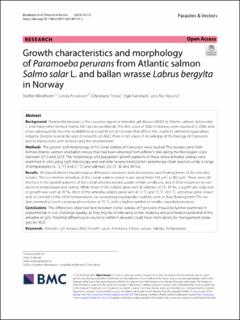| dc.contributor.author | Blindheim, Steffen Hageselle | |
| dc.contributor.author | Andersen, Linda | |
| dc.contributor.author | Trösse, Christiane | |
| dc.contributor.author | Karlsbakk, Egil Erlingsson | |
| dc.contributor.author | Nylund, Are | |
| dc.date.accessioned | 2023-07-06T08:17:04Z | |
| dc.date.available | 2023-07-06T08:17:04Z | |
| dc.date.created | 2023-06-27T09:14:26Z | |
| dc.date.issued | 2023 | |
| dc.identifier.issn | 1756-3305 | |
| dc.identifier.uri | https://hdl.handle.net/11250/3076481 | |
| dc.description.abstract | Background
Paramoeba perurans is the causative agent of amoebic gill disease (AGD) in Atlantic salmon Salmo salar L. and many other farmed marine fish species worldwide. The first cases of AGD in Norway were reported in 2006, and it has subsequently become established as a significant gill disease that affects the country’s salmonid aquaculture industry. Despite several decades of research on AGD, there is still a lack of knowledge of the biology of P. perurans and its interactions with its hosts and the environment.
Methods
The growth and morphology of 10 clonal isolates of P. perurans were studied. The isolates were from farmed Atlantic salmon and ballan wrasse that had been obtained from different sites along the Norwegian coast between 2013 and 2015. The morphology and population growth patterns of these clonal amoeba isolates were examined in vitro using light microscopy and real-time reverse transcription polymerase chain reaction under a range of temperatures (4, 12, 15 and 21 °C) and salinities (20, 25, 30 and 34 ‰).
Results
We found distinct morphological differences between both locomotive and floating forms of the amoeba isolates. The locomotive amoebae of the clonal isolates varied in size (area) from 453 µm2 to 802 µm2. There were differences in the growth patterns of the clonal amoeba isolates under similar conditions, and in their responses to variations in temperature and salinity. While most of the isolates grew well at salinities of 25–34 ‰, a significant reduction in growth was seen at 20 ‰. Most of the amoeba isolates grew well at 12 °C and 15 °C. At 4 °C, amoebae grew slower and, in contrast to the other temperatures, no extended pseudopodia could be seen in their floating form. The isolates seemed to reach a plateau phase faster at 21 °C, with a higher number of smaller, rounded amoebae.
Conclusions
The differences observed here between clonal isolates of P. perurans should be further examined in experimental in vivo challenge studies, as they may be of relevance to the virulence and proliferation potential of this amoeba on gills. Potential differences in virulence within P. perurans could have implications for management strategies for AGD. | en_US |
| dc.language.iso | eng | en_US |
| dc.publisher | BMC | en_US |
| dc.rights | Navngivelse 4.0 Internasjonal | * |
| dc.rights.uri | http://creativecommons.org/licenses/by/4.0/deed.no | * |
| dc.title | Growth characteristics and morphology of Paramoeba perurans from Atlantic salmon Salmo salar L. and ballan wrasse Labrus bergylta in Norway | en_US |
| dc.type | Journal article | en_US |
| dc.type | Peer reviewed | en_US |
| dc.description.version | publishedVersion | en_US |
| dc.rights.holder | Copyright 2023 The Author(s) | en_US |
| dc.source.articlenumber | 112 | en_US |
| cristin.ispublished | true | |
| cristin.fulltext | original | |
| cristin.qualitycode | 1 | |
| dc.identifier.doi | 10.1186/s13071-023-05715-2 | |
| dc.identifier.cristin | 2158298 | |
| dc.source.journal | Parasites & Vectors | en_US |
| dc.identifier.citation | Parasites & Vectors. 2023, 16, 112. | en_US |
| dc.source.volume | 16 | en_US |

